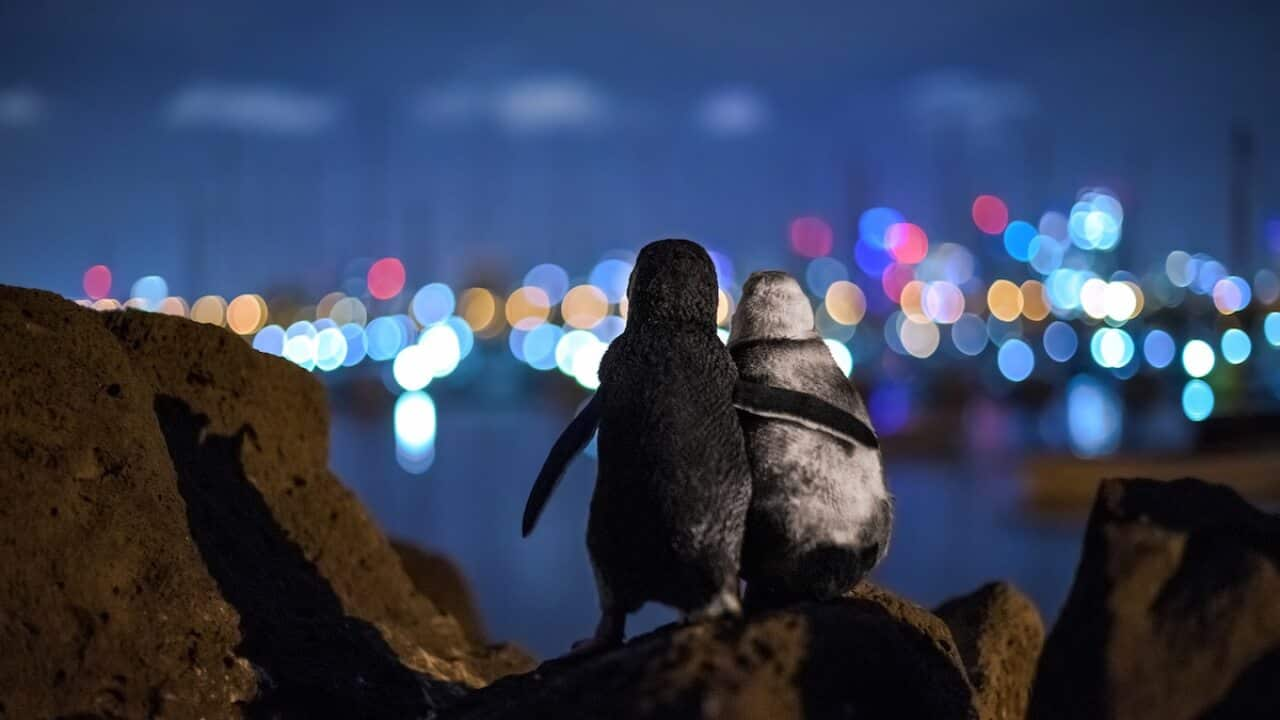Key Points
- In an exclusive interview with SBS German, photographer Tobias Baumgaertner explains the story behind the viral penguin image.
- He said he was at first reluctant to share it for fear of exposing the fragile penguin colony to too many visitors.
- However, he says the picture seems to have not only 'saved' him during the pandemic but given millions of others a reason to smile.
Tobias Baumgaertner was living in Australia when he was told about a Fairy Penguin colony that lived on and around a pier in the middle of the hustle and bustle of Port Phillip Bay, Victoria.
The German filmmaker and marine scientist said he spent three days with the colony on St Kilda Pier.
While observing some of the estimated 1,400 penguins, one pair in particular had caught his eye.
"The two penguins stood out because one of them was grey and because they were standing on a rock for four to six hours. Penguins are usually very active, jumping and running around," Baumgaertner told SBS German.
After taking some videos and photographs, he said he had walked away with the knowledge of having captured something special. But he said he was very reluctant to publish it.
"Social media is creating hot spots (for tourists) as it reaches millions of people," Baumgaertner said.
He said he was concerned that by publishing the photo, it would reveal the location of the colony and draw too many visitors.
This viewpoint is shared by Flossy Sperring, a research coordinator and vice president of Earthcare, which works closely with Parks Victoria to monitor and care for the penguin colony.
"(The penguins) are especially vulnerable as their location exposes them to different threats," she said.
When COVID-19 hit and forced Baumgaertner to return to Germany, he said he not only lost his business but also his social contacts, placing him in a vulnerable position, both financially and emotionally.
'At first, nothing happened. And then it exploded.'
Shortly before the pandemic brought the world to a standstill, National Geographic posted a photo of this colony by another photographer.
Because of this exposure and because no one was able to travel to Australia at the time, Baumgaertner said he decided to post his own photo on his Instagram account.
In his post, Baumgaertner addressed the pandemic and how the lockdowns had forced many into loneliness.
"This resonated with a lot of people," he said.
At first nothing happened. But after a couple of days the photo went viral.
Baumgaertner said he had received several hundred emails a day. He estimated that, in total, he went through 4,500 of them.
"Most of them were from people who had no one to talk to, who had mental (health) issues, who missed other people in their lives or who could not visit their loved ones during COVID-19," he said.
“There were some beautiful stories,” he recalled. "There were people who met and got married because of his picture, others baked penguin cakes or took pictures of themselves embracing and watching a skyline."
Some people even got a penguin tattoo.Tobias Baumgaertner
Criticism for attaching emotions to animals
But there was also criticism of the picture mainly for attaching emotions to the animals.
Baumgaertner agreed with this and said, "We must be careful with anthropomorphising animals. I am all for it if it helps to raise awareness for the environment and animal welfare, but penguins are not humans."
The media has also written extensively about the picture. It has been featured on at least 20 web and news sites world-wide and won the 2020 Community Choice Award of the Ocean Photography Awards.
But, until now, no one has ever contacted Baumgaertner to verify the story behind the two penguins.

Tobias Baumgaertner's work is primarily focussed on the environment and nature conservation. Credit: Supplied
"This is very doubtful," Baumgaertner said.
An Earthcare volunteer had told him the story at the time, but he said he thought it was more likely that they were related, rather than a new pairing.
Sperring agreed: "We could not possibly know (if) any of the information Tobias was told by the volunteer (is true)," she said. It is likely, Sperring said, that it was all made up.
Like Baumgaertner, she said she thought the more likely story was that one of the penguins was the parent of the other, "but we have no way of knowing this for sure," Sperring said.
Despite the criticism and incorrect information, Baumgaertner said: "The picture has done a lot of good for many people and it has somehow saved me."
World Penguin Day is celebrated each year on 25 April, aiming to raise awareness about the flightless birds and preserve their habitats for future generations.
